Nine Forms of Goddess Durga: Goddess Durga is one of the prime goddesses in the Hindu religion. Durga is associated with strength, protection, motherhood, wars and destruction. It is believed that there are nine forms of the goddess Durga, and each is highly revered in Hindu religions. Durga is considered a single deity among some sects of Hinduism, like the followers of Shakti and Shiva.
According to Hindu mythology, the nine forms of Goddess Durga are considered to be the nine stages of Durga during the nine-day war with demon king Mahishashura; the final and the tenth day was when Mahishashura was slain by Goddess Durga and is celebrated as Vijayadashami in the Hindu religion.
What are the Four Types of Navaratri?
Navaratri is celebrated four times a year in Hindu culture. The four Navratris are known as Magha Navaratri, Chaitra Navaratri, Ashada Navaratri and Sharad Navaratri. The most popular being the Sharad Navaratri and Chaitra Navaratri
Also Read: GK Quiz on Hindu Mythology
What Are The Nine Forms of Goddess Durga?
The nine forms of goddess Durga are collectively referred to as Nava Durga, and the nine forms are as follows:
1. Shailaputri
2. Brahmacharini
3. Chandraghanta
4. Kushmanda
5. Skandamata
6. Katyayani
7. Kalaratri
8. Mahagauri
9. Siddhidhatri
Nine Forms of Goddess Durga
1. Shailaputri

The first form of Goddess Durga is known as Shailaputri or Shailaja. “Shaila” means the mountain and this form refers to the daughter of the mountain or Goddess Parvati who was the daughter of King Himavat (personification of the Himalayan Mountains).
Goddess Parvati is considered the reincarnation of Goddess Sati and is depicted as a feminine form with two hands and a crescent moon on her forehead.
She carries a trident in her right hand and a lotus flower in her left. She is depicted with her vahana or ride the “Nandi” bull.
Shailaputri is the first form of Goddess Durga that is worshipped on the first day of Navaratri.
2. Brahmacharini
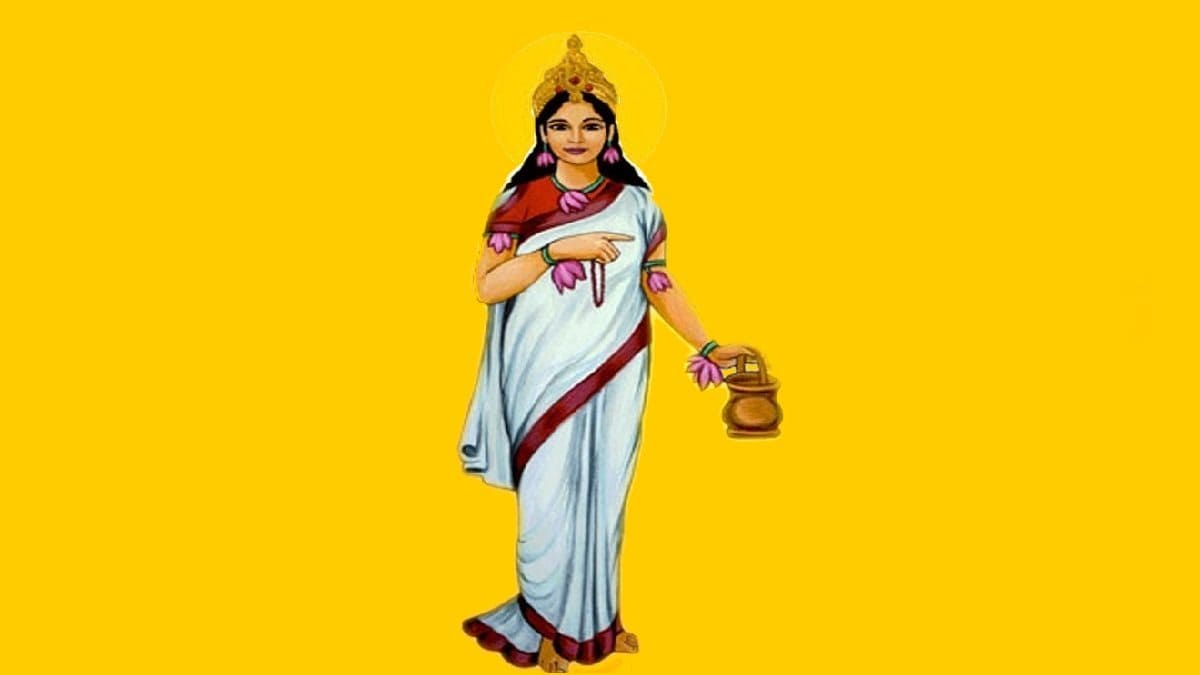
Brahmacharini or the female ascetic form of Goddess Durga is worshipped on the second day of the Navaratri.
She is depicted as a female deity carrying a rosary bead made of dried rudraksha in her right hand and a kamandalu in her left hand.
3. Chandraghanta

The third form of Durga that is worshipped on the third day is Chandraghanta. The goddess is depicted with her third eye open and is always ready for war with demons. She is also known as Ranachandi.
The goddess is depicted as a female deity with 10 hands of which two carry the trident, mace, bow and arrow, khadaga, lotus, ghanta and kamandalu, one of her hands is always in a blessing posture or the abhayamudra which dispels fears.
She has a half moon on her forehead shaped like a bell which also leads to her name being Chandraghanta.
4. Kushmanda
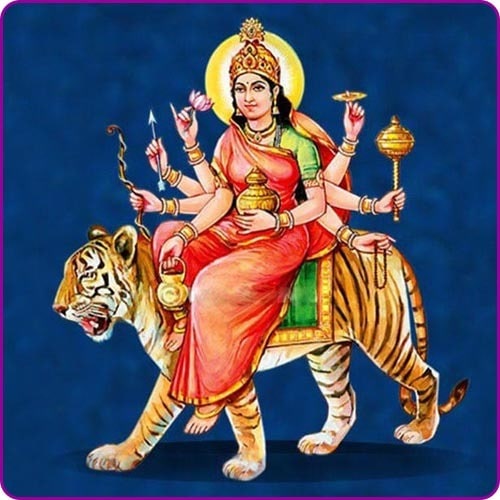
The fourth form of the goddess Durga which is worshipped on the fourth day of Navaratri is the Kushmanda. The name Kushmanda can be broken down into Ku, Ushma and Anda where Ku means "a little", Ushma means "warmth" or "energy" and Anda means "cosmic egg".
This form of goddess Durga is also known as Asthabhuja Devi and she is also known as Adi Shakti who is credited with the creation of the universe.
She is seen mounting a lion as her vahana.
5. Skandamata
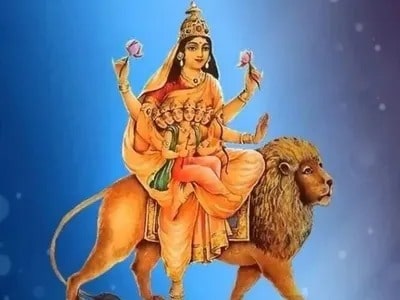
Skandamata is the fifth form of the goddess Durga and is worshipped on the fifth day of Navaratri, this form of the goddess is depicted as a female deity carrying Kartikeya in her lap for this reason Kartikeya is also known as Skanda.
This form of the goddess is depicted as a female deity with four arms, three eyes and mounting on a lion. Of the four arms of the goddess, two carry lotus while of the other two, one carries Karthikeya on one hand and blessing mudra or abhayamudra on the other hand.
6. Katyayani
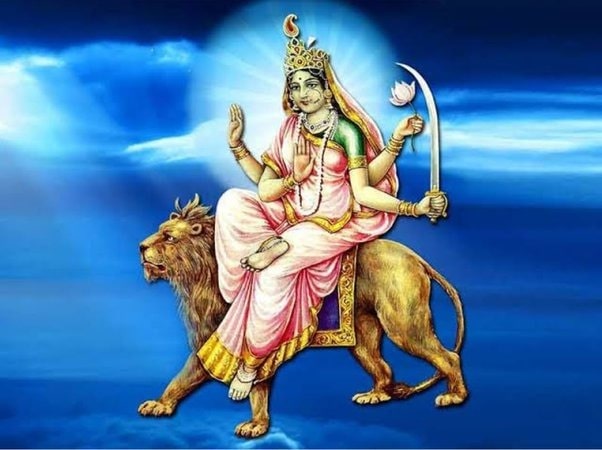
Katyayani is the sixth form of Goddess Durga and is worshipped on the sixth day of Navaratri. She is depicted as the warrior form of Goddess Mahadevi or Durga. The other two fierce forms of Durga are Bhadrakali and Chandika.
This form of goddess Durga is depicted as a female deity mounted on a lion with eighteen arms and various weapons gifted by the gods.
She is known as Katyayani after the sage Katyayana who performed penance of Goddess Durga and asked her to be born as his daughter as a boon.
7. Kalaratri
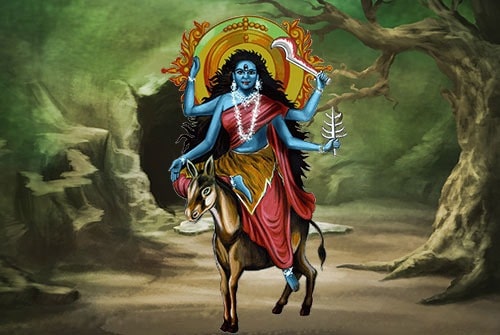
Kalaratri is the seventh and is one of the most violent forms of Goddess Durga. She is the destroyer of darkness and ignorance and is depicted mounted on a donkey, with four arms, two of which are in a blessing and protecting pose while the other two carry a scimitar and a thunderbolt.
She is also sometimes known as Kali.
Kalaratri is worshipped on the seventh day of Navaratri.
8. Mahagauri
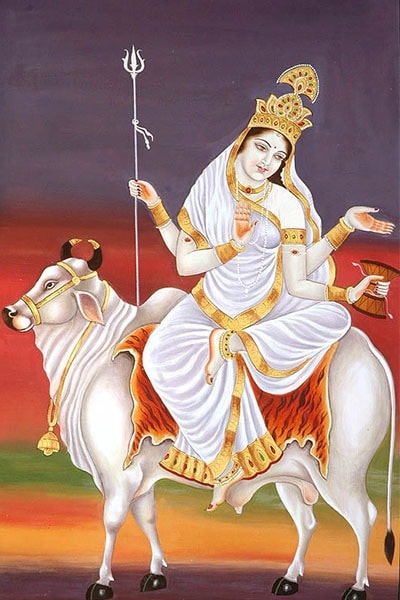
Mahagauri is the eighth form of Goddess Durga and this form is worshipped on the eighth day of Navaratri. This form of the goddess is depicted as a four-armed deity carrying a trident or Trishul on one hand and a damru on her other hand.
The other two arms are for blessing and for dispelling fears which are also known as varada and Abhaya mudra respectively.
She mounts a bull or white elephant.
9. Siddhidhatri
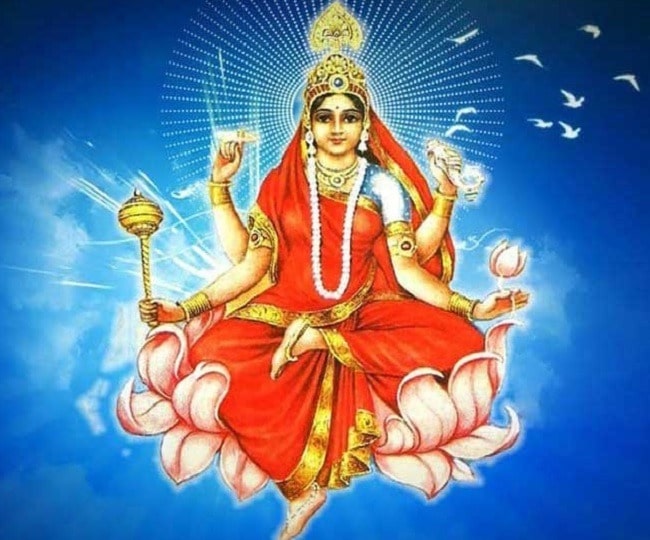
The ninth and the final form of Goddess Durga is Siddhidhatri and she is worshipped on the ninth and final day of Navaratri. She is believed to be the provider of all Siddhis.
This form of the goddess is depicted as a female deity mounted on a lotus and carrying a lotus, a conch or shankha, Gada or mace and chakra or discus on her four hands.
According to Hindu Mythology, she is the embodiment of Mahashakti or the supreme goddess who created the universe and Shiva obtained all the siddhis while praying to the goddess Siddhidhatri.
Comments
All Comments (0)
Join the conversation